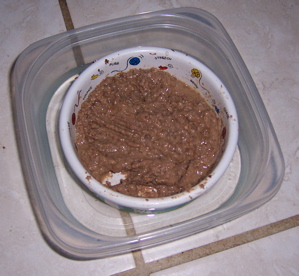Methinks, no. People might eat cultured meat, but they sure as heck won't eat
Frankenmeat!
Romeo's ambivalence to nomenclature proves once and for all that
NASA didn't
fake the whole Shakespeare thing, because the writer of Romeo and Juliet obviously hasn't been exposed to the
5,000 marketing messages a day that we are forced to endure in
this post-modern life.
Not counting Shakespeare, everybody knows that
names matter (including
children).

But perhaps no one knows it better than
Strategic Name, the brand naming company behind the
Baconator. The Baconator is one of the company's proudest accomplishments. You gotta give 'em credit--despite its
manifestly horrifying appearance--when the Baconator came out, people definitely noticed. Here's
what Strategic Name says about the naming of the Baconator:
"America's freshest fast-food company wanted a provocative name for its signature cheeseburger--one that would appeal to younger males. The Baconator assumes the person of the epic Terminator character, and highlights the burger's essential ingredient, bacon, in a playful way. And just as the Terminator is a huge guy, The Baconator is a huge burger with plenty of beef and cheese in addition to the bacon."
Sheer genius. Wendy's
sold 25 million Baconators in the first 8 weeks and it remains one of its top-selling products. If Strategic Name can sell a
heart-attack on a plate (51 grams of fat, 60% more than the Bic Mac), surely we can find some way to sell a burger that is healthier, Greener, safer, and more ethical. Of course, there some uncertainty about whether being healthy, safe, ethical and environmentally-conscious is "attractive" to
consumers. But perhaps it is, with
green marketing's recent rise to prominence.
Maybe I'm getting ahead of myself, here. When Stegeman or some other company does decide to put cultured meat on the market, I'm sure they'll hire a fancy marketing company like Strategic Name to come up with a tasty brand name. Take for example,
Quorn, which
is made in a

somewhat-similar manner as cultured meat. The makers of
Quorn didn't call its product
"mycoprotein foodstuff made from processed
vat grown fungus." Quorn sounds a wee bit more pleasant, doesn't it?
So cultured meat right now is more of a general concept, a general type of food, than an individual branded product. But general food concepts are susceptible to branding, too. For example, detractors of the U.S.'s predominant method of livestock production label it "
factory farming" while the meat lobby/FDA/EPA refer to the method as "
intensive farming practices" or "
Concentrated Animal Feeding Operations."
Likewise, "
organic natural farms" and "
grass-fed beef" sounds a lot better than "
extensive farming," despite the fact that the latter name is indicative of the amount of land needed to produce its product.
(U.N.'s Food and Agriculture Organization found that
70% of the Amazon had been deforestated to allow "grass-fed cattle" to graze. That's one reason why cultured meat is so necessary.)
So what about the topic of this blog? My first introduction to this food that I'm now referring to as as cultured meat was in a newspaper article that called it "
Vat Meat." Talk about "
Yuk factor!"
Proponents like Jason Matheny
most often use the term 'cultured meat' in popular news sources, while scientists (including Jason Matheny) normally use the more technical, but cumbersome term, "in vitro cultured meat" in their
scholarly articles. (Although, Jason Matheny has recently been
calling it hydroponic meat-- but he's been using it more as a way to describe how clean the process can be, as opposed to naming it.)
So what's the most popular? A quick Google search reveals that the term "in vitro meat" dominates the competition in internet references:
1,070,000 - "
in vitro meat"
34,000 - "
cultured meat"
18,000 - "
vat meat"
12,000- "
lab grown meat"
10,000 - "
laboratory meat"
9,000 - "
in vitro cultured meat"
6,000- "
schmeat"
2,500- "
hydroponic meat"
(Note: I left out search terms that may refer to both cultured meat and another product. Notably, artificial meat, which may refer to meat replacements like Quorn, as well as engineered meat and Frankenmeat, which normally refer to genetically modified meat in general.)
I think we can all agree that a tasty name will make consumers more open to the
future of meat. So that naturally leads to the question(s) of the day. I was going to wait a few *days*--when this blog had *millions* of readers--but I just can't wait to ask:
What do
you think the best name is?
Can you come up with a better name?














